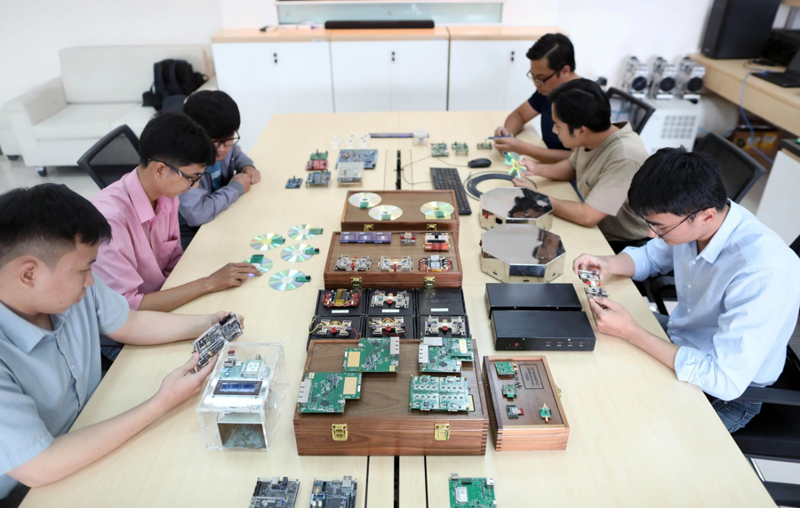Recognizing FDI as a key component of the Strategy for Developing Vietnam’s Semiconductor Industry by 2030, with a Vision to 2050, the government has shown strong political commitment to attracting major semiconductor players to the country in order to boost its national chip industry in the years ahead.
During his recent visit to the US, beyond diplomatic meetings, Party General Secretary and State President To Lam dedicated significant time to engaging with American tech companies, with discussions focusing on expanding partnerships to develop ecosystems and high-quality talent and in particular emphasizing Vietnam’s growing semiconductor sector.
Vietnam is actively implementing policy reforms and creating favorable conditions to attract foreign investors and companies to its chip industry. Minister of Planning and Investment Nguyen Chi Dung said recently that the ministry is drafting a groundbreaking reform proposal aimed at advancing the national semiconductor industry.
The proposal includes semiconductor firms interested in operating within economic zones, high-tech parks, and special export processing zones registering for investment and receiving approval within just 15 days. If given the green light, this policy could significantly bolster Vietnam’s ability to attract both domestic and foreign semiconductor companies.
Selective approach
In an interview with VET / VnEconomy, Dr. Nguyen Nhat Quang, Member of the Vietnam Software Association (VINASA)’s Founding Council and Director of the VINASA Science and Technology Institute, emphasized that semiconductors are integral to Vietnam’s broader national development. The government is determined to build the country’s technological mastery, and attracting key industry players is a crucial step towards strengthening its internal capabilities.
As a highly-globalized industry, no single country, not even tech giants like the US or China, can fully dominate semiconductor technology. Dr. Quang pointed out that by collaborating with major players in the semiconductor supply chain, Vietnam can position itself to participate in critical stages of this global value chain.
He also highlighted that the government’s strategic vision, particularly the term “selective” in the national semiconductor development strategy, is on point. The semiconductor industry encompasses a wide array of technologies, from low-cost chips to highly-valuable chips. If Vietnam spreads itself too thinly by trying to produce everything, given its limited resources and workforce, it could impede the industry’s growth.
Thus, the country should focus on high-value sectors that align with its existing strengths. “Though all chips are made from silicon, their true value lies in the intelligence embedded within each one,” he said. “If Vietnam aims to build a competitive semiconductor industry, it must partner with leading players in the global supply chain. Naturally, this is a challenge, as other markets are also working hard to capitalize on the ongoing global semiconductor supply chain shift.”
Economies around the world are indeed competing to create attractive policies and investment opportunities to attract top semiconductor companies. India, for instance, has invested billions of dollars in developing favorable conditions for FDI in the semiconductor sector. Malaysia, meanwhile, has been developing its semiconductor capabilities since the 1970s and now boasts an established ecosystem with a skilled workforce.
Experts argue that Vietnam needs to adopt a unique competitive strategy, backed by a strong vision and the right mindset. Recent government initiatives suggest that it is betting on human resources, with a focus on training a highly-skilled workforce, to attract major semiconductor companies.
According to Mr. Nguyen Thanh Yen, General Director of CoAsia Semi Vietnam, part of South Korea’s CoAsia Corporation, human resources - specifically design engineers - are crucial in chip design. Vietnam is gaining recognition as a human resources hub with competitive labor costs. More importantly, it is in a demographic sweet spot, with many well-known global chip design companies now turning their attention to the country.
Lessons for latecomers
Mr. Yen has observed, in Co-Asia’s four years in Vietnam, Vietnamese engineers demonstrate their competence, earning positive recognition from the foreign management team. “This will undoubtedly influence the group’s future decisions to expand its workforce and explore business opportunities in Vietnam,” he told VET / VnEconomy.
However, experts point out that Vietnam’s development environment still faces several challenges, including issues with land laws, taxation, and work permits. “I believe government leaders are aware of these weaknesses,” Dr. Quang said. “Once one leading FDI company enters Vietnam, it will bring along a whole ecosystem. Vietnam still has significant work to do in creating a favorable environment, from legal frameworks to infrastructure.”
While Vietnam offers many incentives to attract investment in the semiconductor industry, Mr. Yen frankly added that CoAsia Semi Vietnam has yet to fully experience these benefits based on their operations thus far.
“In my opinion, Vietnam’s policies are well-crafted, but implementation has not been aggressive enough,” he said. “The government should provide clearer, more practical guidelines to ensure that both foreign and local companies - regardless of size - can easily access tax and infrastructure incentives. This would help solidify Vietnam’s semiconductor ecosystem as it grows.”
Countries like Singapore, Thailand, and Malaysia have already established infrastructure, technological expertise, and a highly-skilled workforce, while offering special incentives to drive semiconductor growth. Competing with these countries using conventional methods would require a level of investment that currently surpasses Vietnam’s capabilities.
However, Mr. Yen highlighted that these countries also heavily rely on FDI and lack large domestic companies that can lead the industry. An overdependence on FDI can hinder the growth of local businesses over time; a lesson Vietnam should take to heart.
“Though Vietnam is a latecomer, it has the advantage of learning from others’ experience and adopting successful models,” he concluded. “Most importantly, Vietnam’s greatest strength lies in its people. I am confident that it will find its own path; one that aligns with its existing conditions.”









 Google translate
Google translate